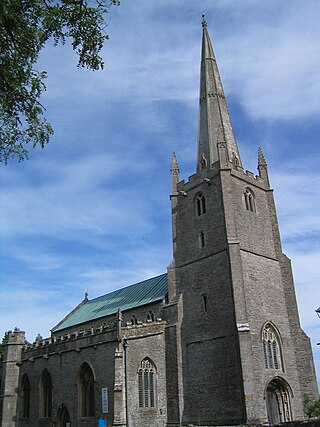
Sedgemoor is a low-lying area of land in Somerset, England. It lies close to sea level south of the Polden Hills, historically largely marsh. The eastern part is known as King's Sedgemoor, and the western part West Sedgemoor. Sedgemoor is part of the area now known as the Somerset Levels and Moors. Historically the area was known as the site of the Battle of Sedgemoor.

North Somerset is a unitary authority in the ceremonial county of Somerset, England. The council is based in Weston-super-Mare, the area's largest town. The district also contains the towns of Clevedon, Nailsea and Portishead, along with a number of villages and surrounding rural areas. Some southern parts of the district fall within the Mendip Hills, a designated Area of Outstanding Natural Beauty.

Congresbury is a village and civil parish on the northwestern slopes of the Mendip Hills in North Somerset, England, which in 2011 had a population of 3,497. It lies on the A370 between Junction 21 of the M5 and Bristol Airport, 13 miles (21 km) south of Bristol city centre, and 7 miles (11 km) east of Weston-super-Mare. The Congresbury Yeo river flows through the village. The parish includes the hamlet of Brinsea.

Weston-super-Mare is a constituency represented in the House of Commons of the UK Parliament by Dan Aldridge from the Labour Party since 2024. Before then it was held since 2005 by John Penrose, a Conservative.

Wells was a constituency in Somerset in the House of Commons of the UK Parliament. Apart from between 2010–2015, Wells was represented by members of the Conservative Party since 1924.
Avon was abolished in 1996 both as a county council and a ceremonial county, being succeeded by the unitary authorities of Bath and North East Somerset, Bristol, North Somerset, and South Gloucestershire. The constituency boundaries used up to the 2005 United Kingdom general election were drawn up when the county still existed. For the review which came into effect for the 2010 general election, the four authorities were considered separately, entailing four seats for Bristol, three for South Gloucestershire and two each for Bath and North East Somerset and North Somerset.
The county of Somerset is currently divided into 7 parliamentary constituencies, which are all county constituencies. Three seats cross the county boundary - two are shared with Avon and one with Devon.

Winscombe is a large village in the North Somerset unitary district of Somerset, South West England, close to the settlements of Axbridge and Cheddar, on the western edge of the Mendip Hills, 7 miles (11 km) southeast of Weston-super-Mare and 14 miles (23 km) southwest of Bristol. The Parish of Winscombe and Sandford, centred on the Parish Church of Church of St James the Great, includes the villages/hamlets of Barton, Hale, Oakridge, Nye, Sidcot and Woodborough.

Churchill is a village and civil parish in the unitary authority of North Somerset, part of the ceremonial county of Somerset. It is located on the western edge of the Mendip Hills, about 8 miles (12.9 km) east of Weston-super-Mare, and about 15 miles (24.1 km) south-west of Bristol. The parish, which includes the village of Lower Langford and the hamlet of Upper Langford, has a population of 2,250.
Axbridge was a rural district in Somerset, England, from 1894 to 1974. It was named after the town of Axbridge.

North Somerset is a constituency represented in the House of Commons of the UK Parliament since 2024 by Sadik Al-Hassan of the Labour Party.

The A371 is a primary road in England running from Wincanton to Weston-super-Mare in North Somerset, through Shepton Mallet, Croscombe, Wells, Westbury-sub-Mendip, Rodney Stoke, Draycott, Cheddar, Axbridge, Winscombe, Banwell and Weston-super-Mare.
The Cheddar Valley line was a railway line in Somerset, England, running between Yatton and Witham. It was opened in parts: the first section connecting Shepton Mallet to Witham, later extended to Wells, was built by the East Somerset Railway from 1858. Later the Bristol and Exeter Railway built their branch line from Yatton to Wells, but the two lines were prevented for a time from joining up. Eventually the gap was closed, and the line became a simple through line, operated by the Great Western Railway.

Sandford is a village between Churchill and Banwell on the A368 in North Somerset, England.
The BS postcode area, also known as the Bristol postcode area, is a group of 37 postcode districts in South West England, within eight post towns. These cover the city of Bristol, north Somerset and south Gloucestershire.

The Hundred of Winterstoke is one of the 40 historical Hundreds in the ceremonial county of Somerset, England, dating from before the Norman conquest during the Anglo-Saxon era although exact dates are unknown. By far the most important and authoritative source for the structure, history and development of Winterstoke Hundred is a seminal paper by Dr Frank Thorn. Each hundred had a 'fyrd', which acted as the local defence force and a court which was responsible for the maintenance of the frankpledge system. They also formed a unit for the collection of taxes. The role of the hundred court was described in the Dooms (laws) of King Edgar. The name of the hundred was normally that of its meeting-place.












